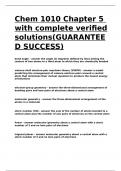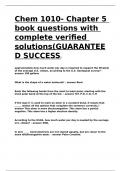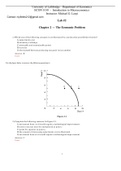Chem 1010 chapter 5 - Study guides, Class notes & Summaries
Looking for the best study guides, study notes and summaries about Chem 1010 chapter 5? On this page you'll find 3 study documents about Chem 1010 chapter 5.
All 3 results
Sort by

-
Chem 1010 Chapter 5 with complete verified solutions(GUARANTEED SUCCESS).
- Exam (elaborations) • 5 pages • 2024
-
- $14.99
- + learn more
bond angle the angle (in degrees) defined by lines joining the centers of two atoms to a third atom to which they are chemically bonded valence-shell electron-pair repulsion theory (VSEPR) a model predicting the arrangement of valence electron pairs around a central atom that minimizes their mutual repulsion to produce the lowest energy orientations electron-group geometry the three-dimensional arrangement of bonding pairs and lone pairs of electrons about a central atom ...

-
Chem 1010- Chapter 5 book questions with complete verified solutions(GUARANTEED SUCCESS)
- Exam (elaborations) • 9 pages • 2024
-
- $14.99
- + learn more
approximately how much water per day is required to support the lifestyle of the average U.S. citizen, according to the U.S. Geological survey? 100 gallons What is the shape of a water molecule? Bent Rank the following bonds from the most to least polar, starting with the most polar bond at the top of the list. H-F, P-O, C-O, C-H if the sign δ- is used to mark an atom in a covalent bond, it means that _____. (select all the options that complete the sentence correctly.) ...

-
ECON 1010 - Introduction to Microeconomics Instructor: Michael G. Lanyi
- Exam (elaborations) • 177 pages • 2022
-
- $13.99
- + learn more
ECON 1010 - Introduction to Microeconomics Instructor: Michael G. LanyiWhich one of the follow ing concepts is not illu strated by a p rod u ction p ossibilities frontier? A) op p ortu nity cost B) monetary exchange C) attainable and u nattainable p oints D) scarcity E) the trad eoff betw een prod ucing one good versus another Answer: B User1: Use the figure below to answer the following question(s). Figure 2.1 2) Complete the follow ing sentence. In Figure 2.1, A) movement from c to b w ould re...

How much did you already spend on Stuvia? Imagine there are plenty more of you out there paying for study notes, but this time YOU are the seller. Ka-ching! Discover all about earning on Stuvia


